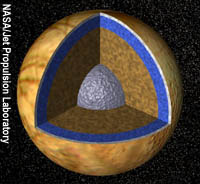The Search for Life in the Solar System

by Tim Porter
 |
While generations of cloned mice and asteroids the size of Texas dominate science in popular culture today, a NASA probe is quietly studying one of the most interesting objects in the solar system, Jupiter's fourth moon Europa. Slightly smaller than Earth's moon, Europa is one of only four moons in the solar system with an atmosphere. More importantly, scientific data suggest an ocean of slush and water –as deep as 50 kilometers– below Europa's icy surface. If such an ocean exists, Europa is one of the few possible places in the solar system where life is possible.
The Little Space Probe that Could
After a six-year journey from Earth, the Galileo spacecraft (named after Galileo Galilei, who discovered Jupiter's four largest moons) reached Jupiter on December 7, 1995. Since then, the spacecraft has gathered data on Jupiter and her four largest moons, and its mission is currently concentrated on Europa. Galileo has proven to be quite durable, already lasting longer than originally expected, and is scheduled to continue operating until December 31, 1999.
Fire and Ice
There are several reasons why scientists theorize that Europa is covered with a subsurface ocean below an icy crust. Pictures taken by the Galileo spacecraft show that Europa has an extremely smooth surface with very few craters. Such geologic evidence suggests young, changing surface features. In contrast, the Moon, whose surface has remained unchanged for billions of years, is pockmarked with thousands of craters, while only three craters larger than 5 kilometers wide have been discovered on Europa. Scientists use crater counts to help estimate the age of celestial surfaces —more craters lends to a older surface— since the chances for impact are approximately equal throughout the solar system. Large portions of Europa's surface appear very similar to ice floes near the North Pole of Earth. Thousands of dark lines criss-cross the entire surface of Europa, separating the crust into plates, and resemble fault lines on Earth. Scientists believe these lines result as water from below fills the fractures when the surface crust separates and then freezes into place.
Europa's sister moon Io demonstrates much different surface activity. Closer to Jupiter than Europa, Io is incessantly heated by Jupiter's massive gravitational pull. As a result, volcanoes cover the surface of Io in stark contrast to Europa's icy features. This gravitational heating could also take place on Europa, although to a much smaller degree. Such internal heating could cause high enough temperatures to allow for liquid water inside of Europa's icy crust. If there is water and heat there is a chance, however small, for life to exist.







